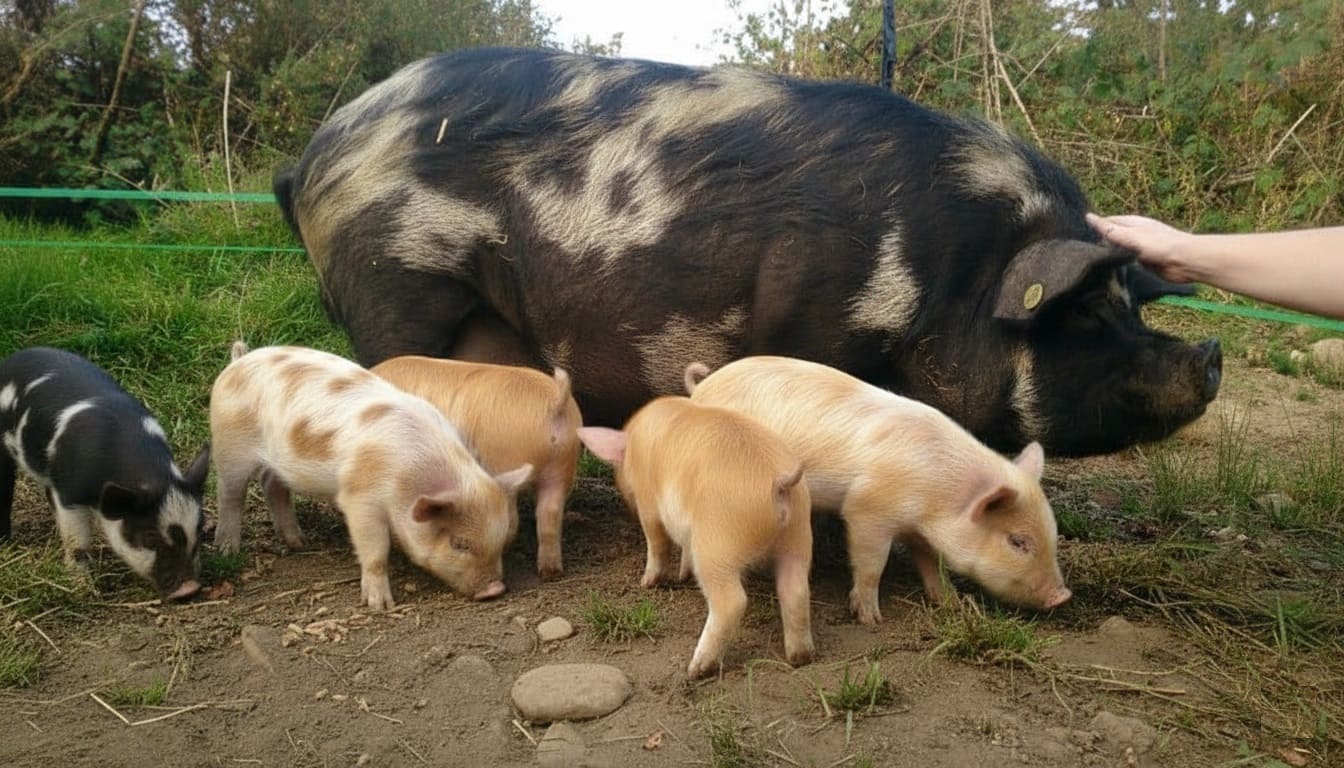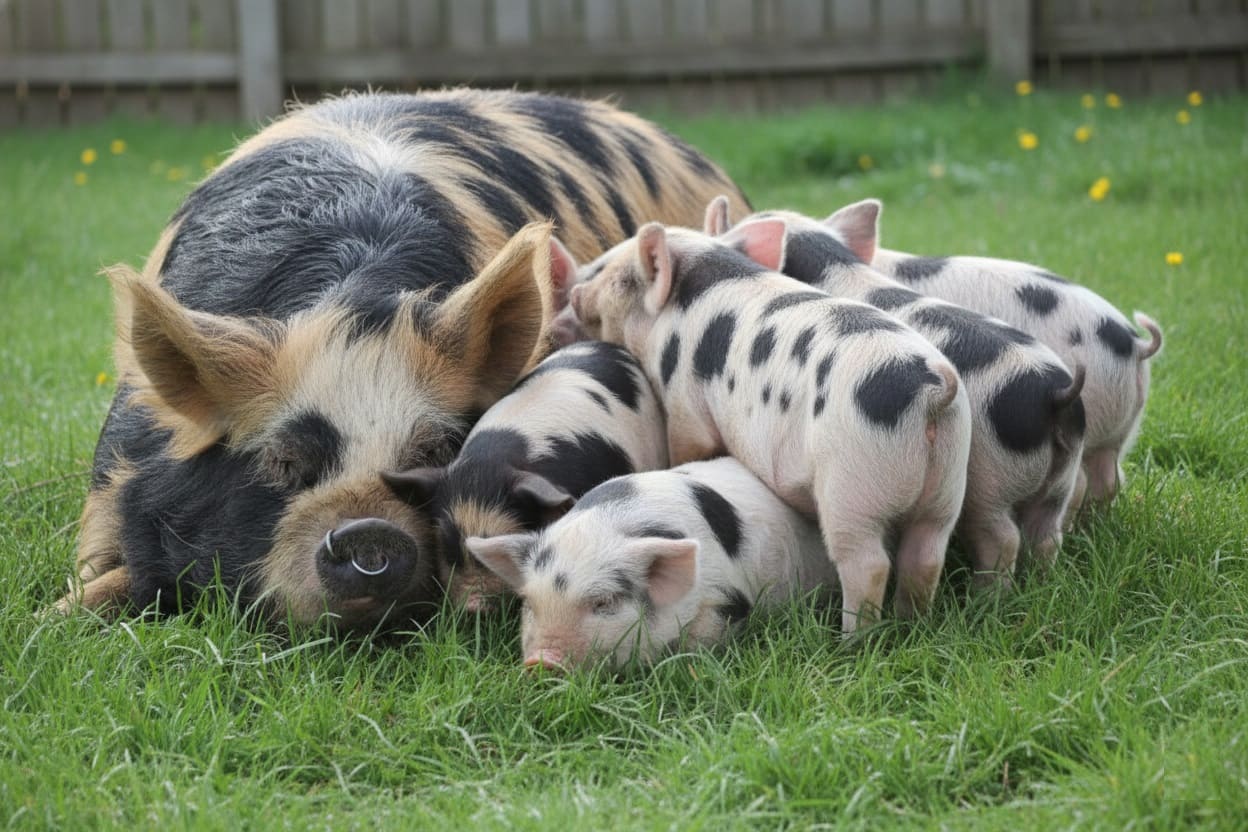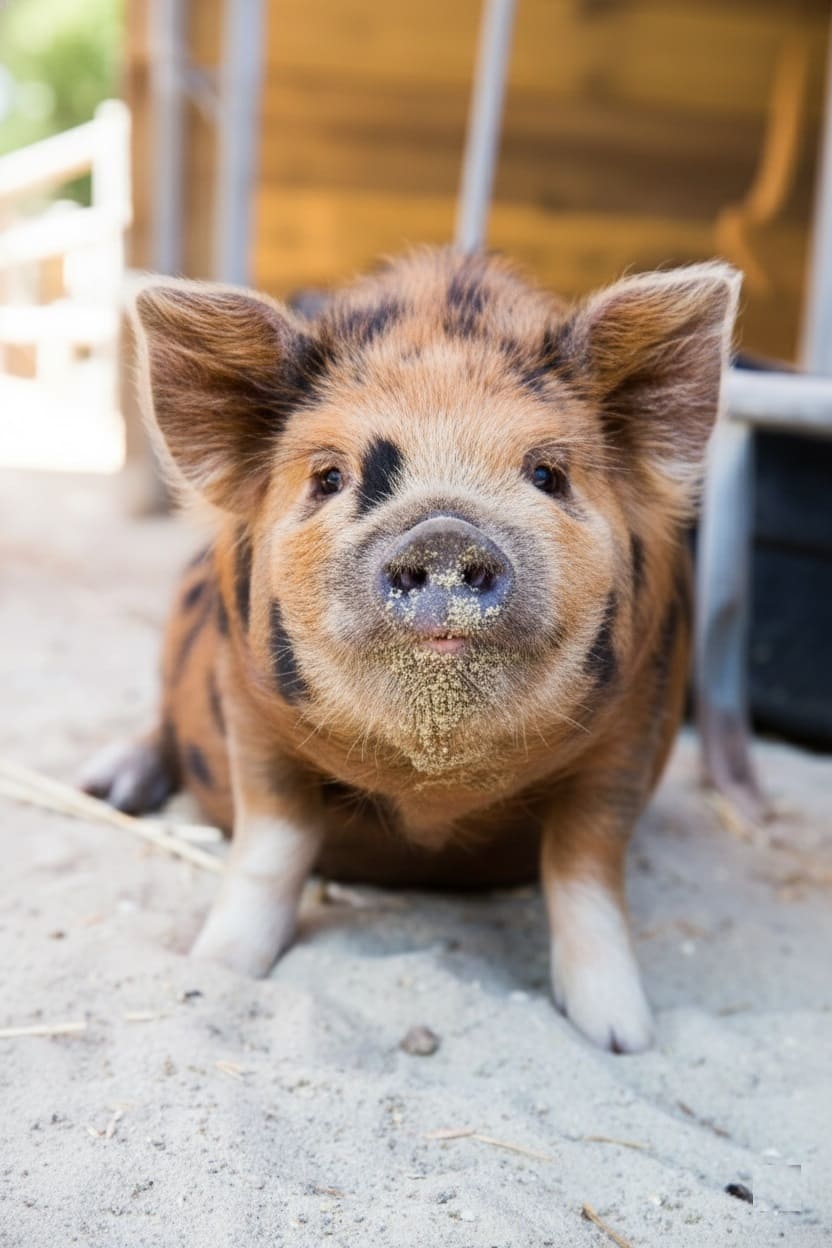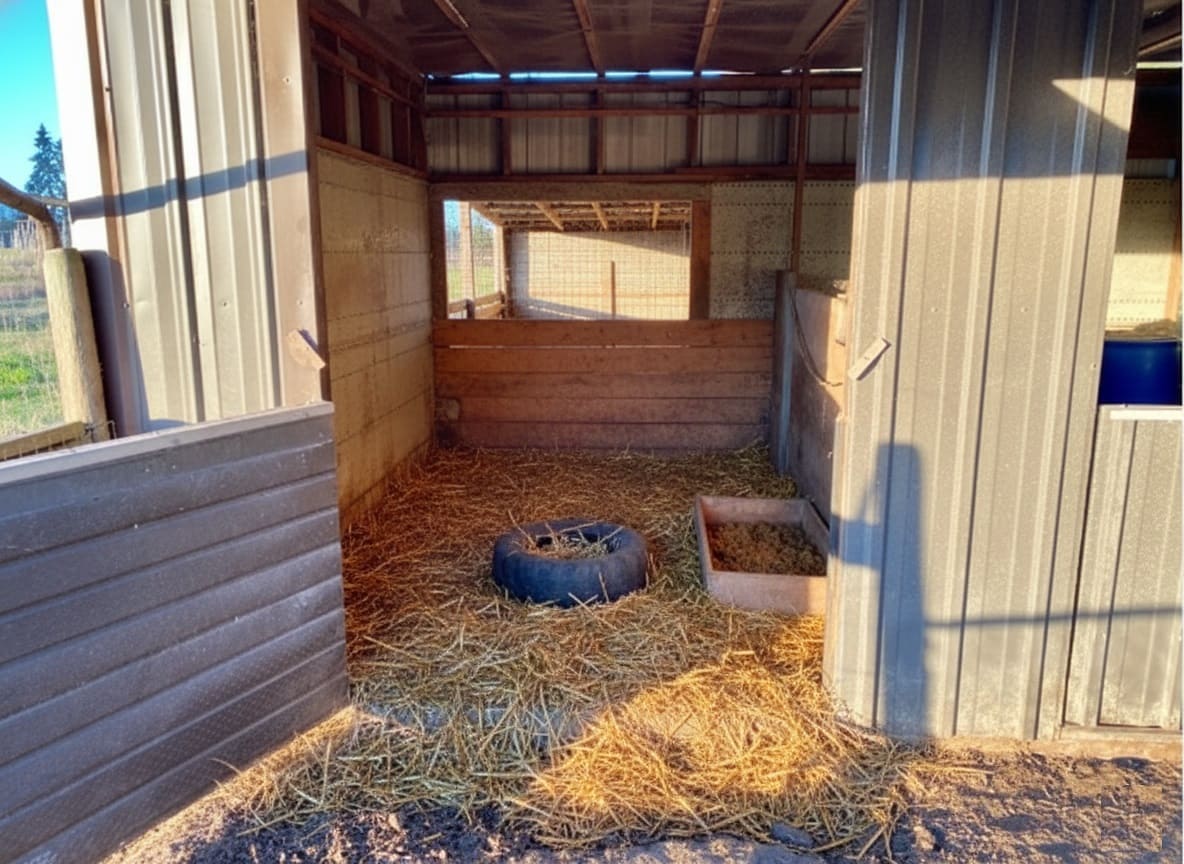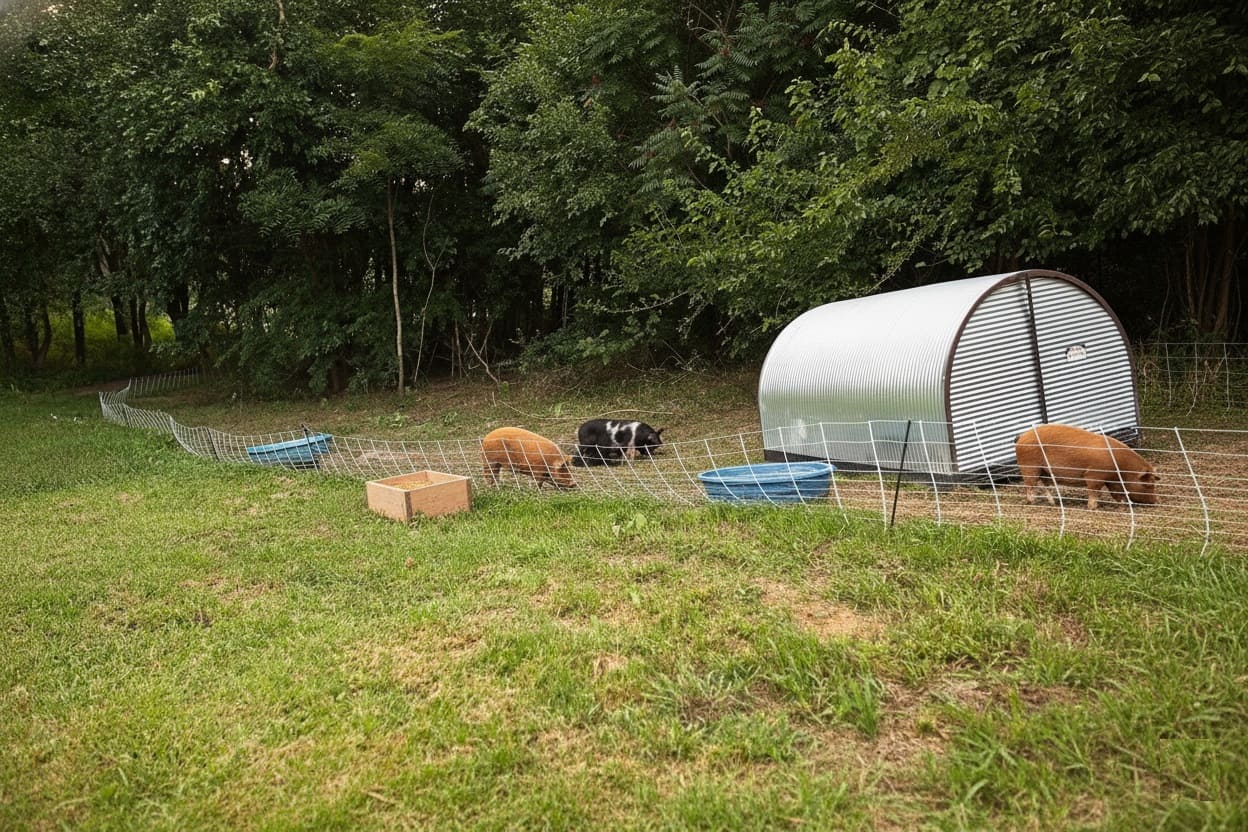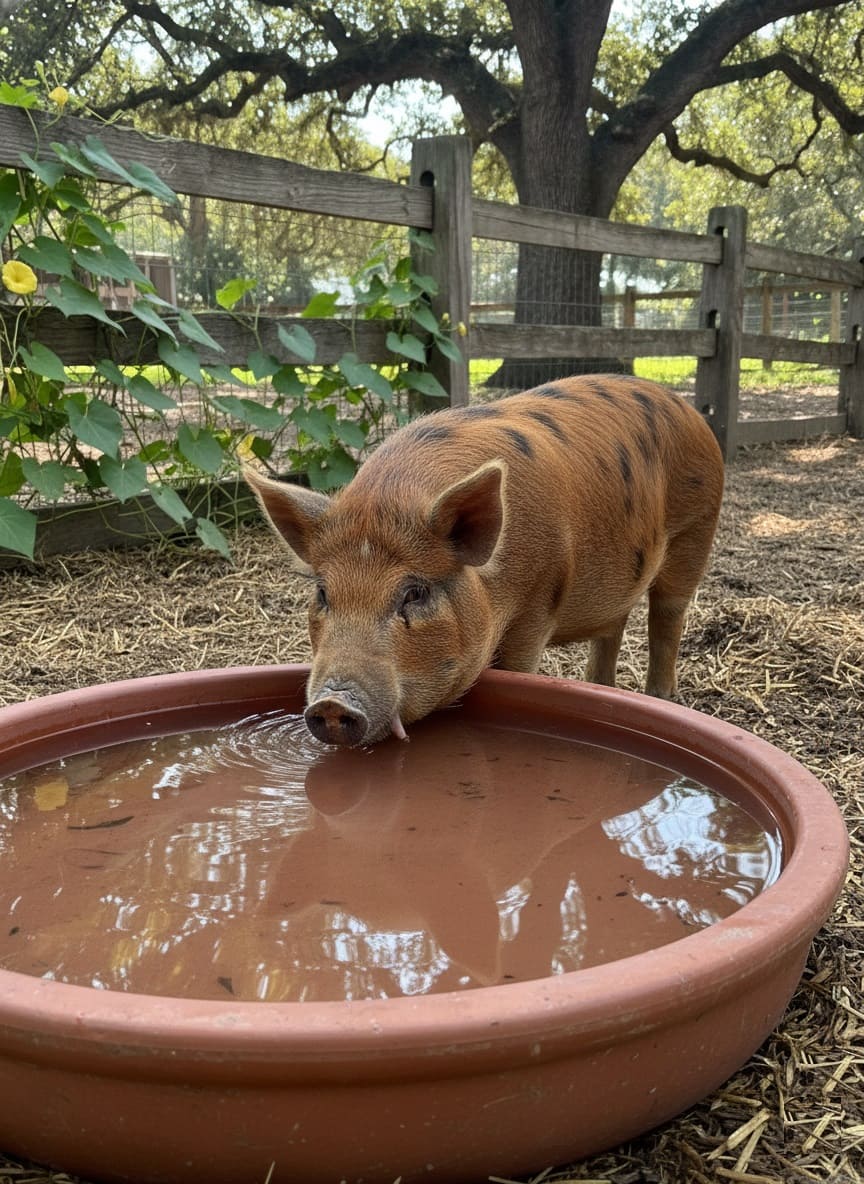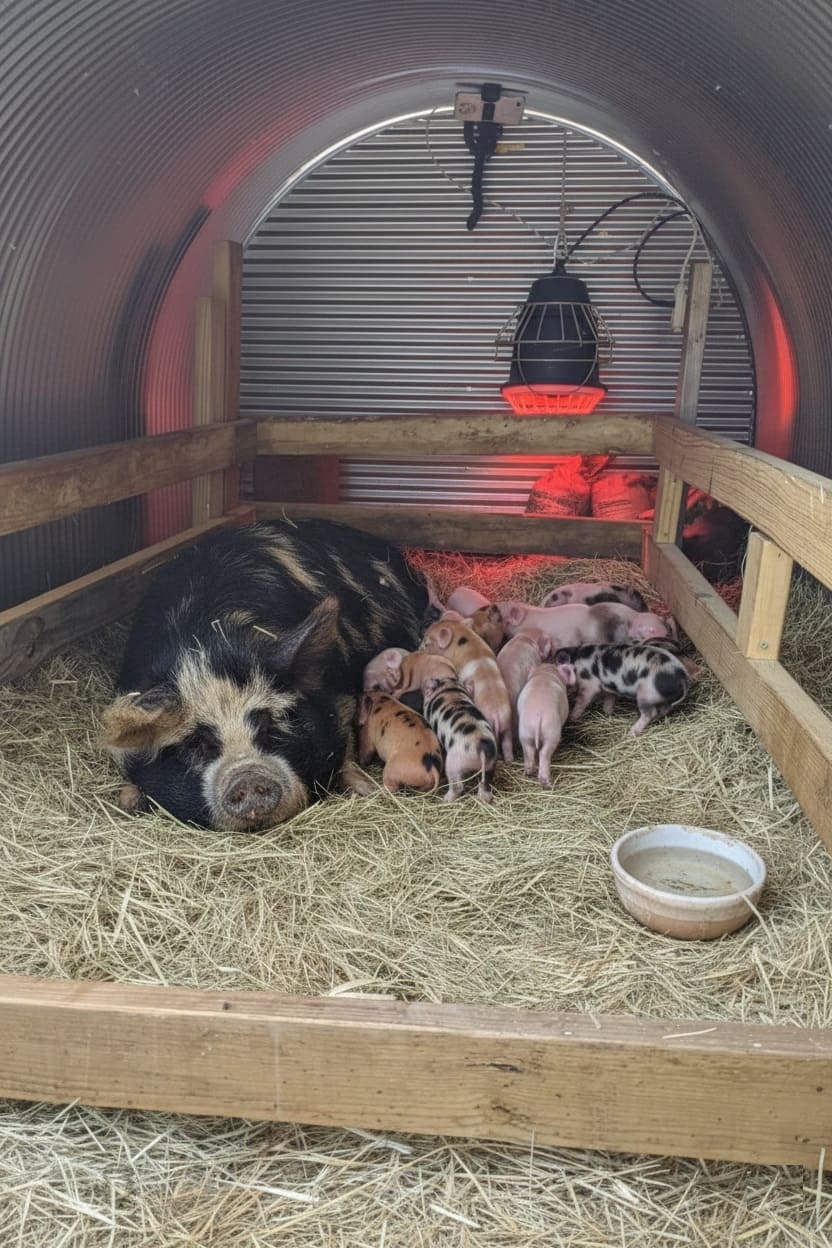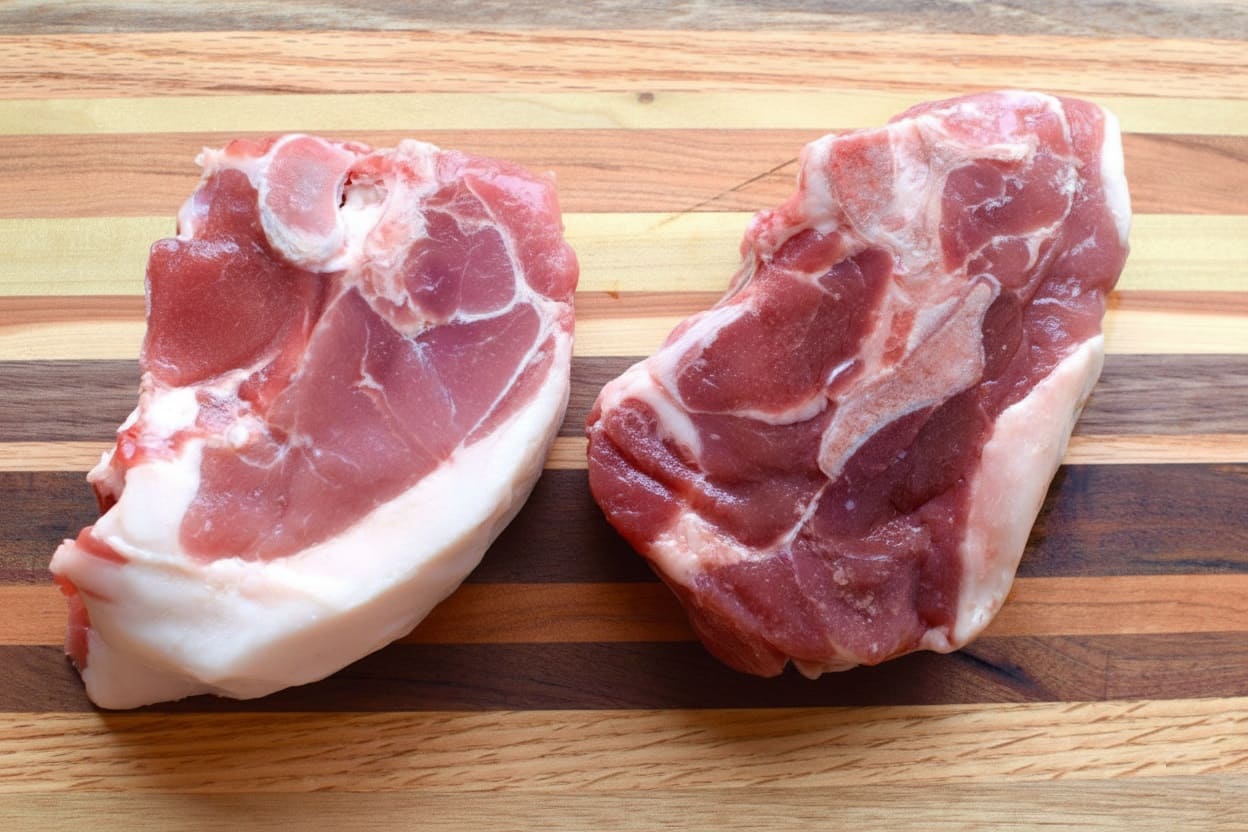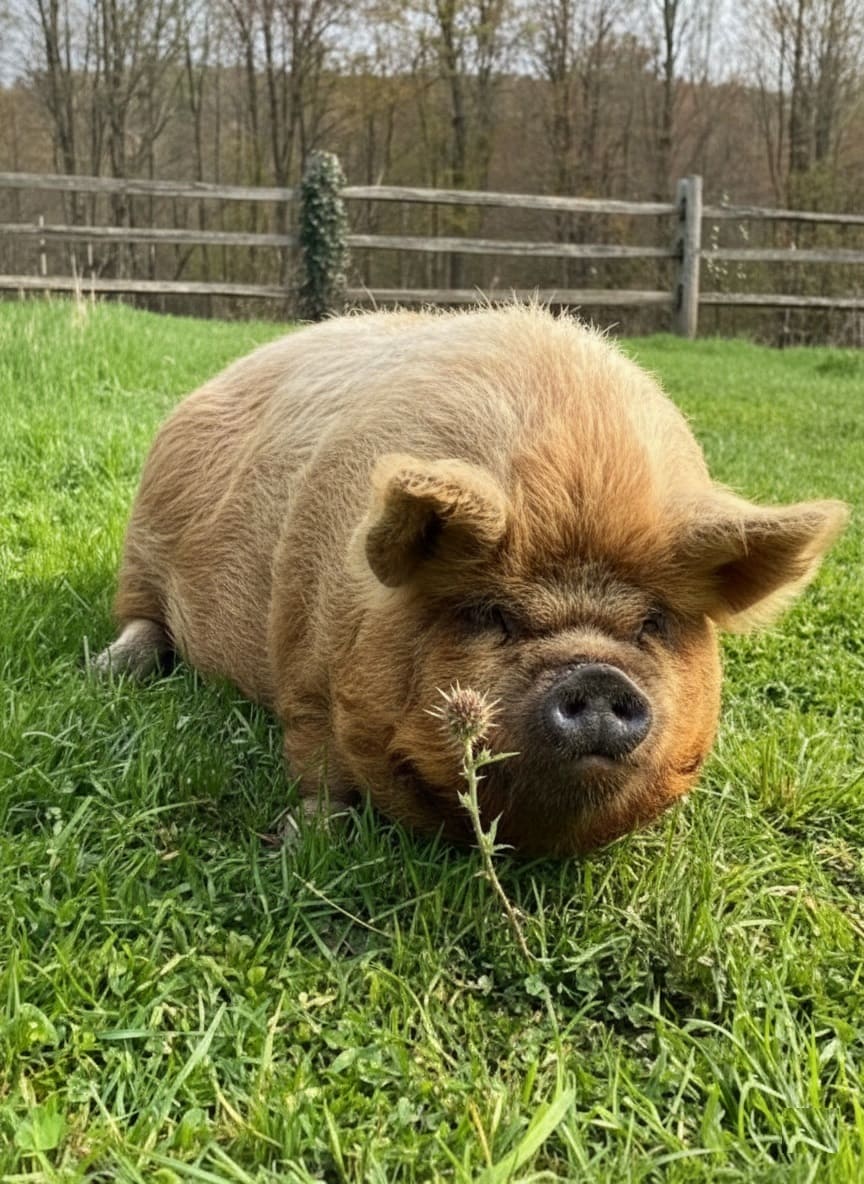Imagine a pig that grazes like a sheep, cuddles like a dog, and produces pork so exceptional it’s been compared to Kobe beef. Sounds too good to be true?
Meet the Kunekune—a breed that nearly vanished in the 1970s but has made a remarkable comeback to become one of the most beloved animals on small farms worldwide.
Whether you’re considering adding pigs to your homestead for the first time, searching for a sustainable meat source, or simply curious about these enchanting creatures with their distinctive wattles and upturned snouts, this guide covers everything you need to know.
We’ll explore what makes them different from other pig breeds, bust some dangerous myths about “miniature pigs,” and help you decide if these intelligent grazers are right for your lifestyle and land.
👉 Find out Why Duroc Pigs Are Every Farmer’s Secret to Profit
The Remarkable Journey: From Extinction’s Edge to Backyard Hero
The Kunekune’s story begins in New Zealand, though these pigs aren’t native there. Most evidence suggests Asian domestic pigs arrived during the early 1800s, likely brought by whalers or traders.
The distinctive wattles (called “piri piri” in Māori) hanging from their lower jaws hint at Asian ancestry, appearing on pigs from Indonesia and other Pacific regions.
What transformed them into Kunekunes was the Māori people’s selective breeding. They embraced these pigs for their docile nature and reluctance to roam—qualities perfect for unfenced villages.
Unlike the larger, destructive European pigs that decimated gardens, Kunekunes stayed close to home and grazed peacefully. The Māori valued them for ceremonial feasts, prizing both the flavorful meat and abundant fat used for preserving other foods.
By the late 1970s, disaster loomed. As New Zealand modernized and commercial pig farming expanded, these small, slow-growing pigs fell out of favor.
When wildlife park owners Michael Willis and John Simister began investigating in the mid-1980s, they discovered fewer than 50 purebred Kunekunes remained, kept almost exclusively by Māori communities in remote areas.
Their rescue mission became legendary. Traveling across New Zealand, Willis and Simister managed to gather just 18 pigs—6 sows and 3 boars from unrelated bloodlines. This tiny foundation saved the breed.
Today, thousands of Kunekunes exist across multiple countries, thanks to strategic exports to the UK (1992) and America (1995), with additional bloodlines imported in 2005 and 2010.
The American Kunekune Pig Society now tracks 25 distinct bloodlines, ensuring genetic diversity for generations to come.
What Makes Kunekunes Different: Essential Breed Characteristics
Size Reality: Setting Honest Expectations
Let’s address this directly: there is no such thing as a micro, teacup, or truly miniature pig. Kunekunes are the world’s smallest domesticated pig breed, but “smallest” is relative.
Adult sows typically weigh 120-200 pounds, while boars range from 200-300 pounds, with some individuals reaching 400 pounds. They stand approximately 24 inches tall at the shoulder when fully mature around 2-3 years old.
That tiny 13-pound piglet you bring home at 8-9 weeks will eventually become a substantial animal. This isn’t deceptive—it’s biology.
When evaluating piglets, look at the parents and siblings to understand adult potential. Responsible breeders will show you breeding stock and discuss realistic size expectations.
Distinctive Physical Features
Kunekune coats range from short and silky to long and curly, creating looks from sleek to delightfully shaggy. Seasonal shedding is normal—many pigs lose significant hair during summer as a natural cooling adaptation.
Color variations are extraordinary: solid black, brown, ginger, cream, white, or combinations like black-and-white, ginger-and-black (called “gold tip”), and even tricolored patterns with random spots.
The breed’s most famous feature is piri piri—fleshy wattles approximately 4 centimeters long dangling from the lower jaw. While considered a trademark, not all purebred Kunekunes have them.
Wattles are controlled by dominant genetics but aren’t universal. Piglets can have two, one, or none. These serve no biological function but distinguish Kunekunes as one of only three pig breeds worldwide with this characteristic.
Their medium-to-short, upturned snout isn’t just cute—it’s functional. This “dished face” makes them exceptional grazers while discouraging the destructive rooting typical of other breeds.
Their nose structure naturally positions them to crop grass like sheep rather than excavate your pasture.
Temperament: The Kunekune Superpower
If Kunekunes have one defining trait, it’s their extraordinary temperament. These pigs actively seek human interaction and affection.
Unlike livestock that merely tolerate handling, Kunekunes genuinely enjoy belly rubs, ear scratches, and lounging beside their favorite humans.
Their intelligence rivals dogs—they learn routines quickly, recognize individuals, and respond to training with positive reinforcement. A 2017 study highlighted their “astonishingly good memory” and remarkable social learning abilities.
This gentle nature makes them particularly suitable for families, though adult supervision remains essential with any livestock.
However, understand the exceptions: intact boars can become aggressive, especially during breeding season.
Even the sweetest boar may suddenly display territorial or protective behaviors. Never turn your back on a breeding boar, always carry sorting boards as shields, and respect their size and strength.
Kunekunes are fundamentally social creatures who form complex relationships, creating hierarchies, friendships, and sleeping “cuddle-puddles.” While they can live alone with other animal companions, they’re happiest with at least one pig friend.
Daily Time Commitment: What to Actually Expect
Before bringing home Kunekunes, understand the daily reality. Plan for 30-60 minutes daily for basic care, including:
- Morning feeding and water check: 15-20 minutes
- Evening feeding and water check: 15-20 minutes
- Observation and interaction: 10-15 minutes
- Pen/shelter cleaning: 10-30 minutes (daily spot-cleaning or 2-3 times weekly deep-clean depending on setup)
Add weekly tasks like moving electric fencing (if rotationally grazing), checking fence integrity, and deep-cleaning waterers.
Seasonal demands increase with breeding (monitoring sows, assisting farrowings if needed) and butchering (coordinating appointments, transport).
The reality is that Kunekunes are less labor-intensive than many livestock species, but they’re not zero-maintenance pets. Missing even one day of water checks can be dangerous. Plan for vacation coverage or automatic waterers if you travel frequently.
👉 Can You Keep a Goat as a Pet? Essential Insights & Care Tips
The Grazing Advantage: Revolutionizing Small-Farm Pig Keeping
Kunekunes are the only pig breed that truly grazes like ruminants. While other pigs can eat grass, they typically root through soil searching for protein-rich roots, grubs, and earthworms.
Kunekunes, with their upturned snouts and inherited grazing behavior, contentedly munch grass, clover, and forbs like miniature cows.
This offers tremendous practical advantages. During growing season (roughly April through October in temperate climates), mature Kunekunes on quality pasture can maintain healthy body condition with minimal grain supplementation—dramatically reducing feed costs compared to conventional pig farming, where expensive grain comprises nearly 100% of the diet.
Rooting Reality: Managing Expectations
Despite marketing claims that Kunekunes “never root,” the reality is more nuanced. Most root significantly less than other breeds, but individual variation exists.
Many owners report their pigs root primarily during mid-April and mid-October. These windows seem to coincide with nutrient needs—seeking minerals in emerging spring growth or stocking up before winter dormancy.
Several factors influence rooting behavior. Well-fed pigs with quality forage root less. Pigs moved frequently across fresh paddocks have less incentive to dig. Conversely, pigs in small, overgrazed areas or fed inadequate diets may root extensively.
Providing mineral supplements and ensuring pasture quality helps minimize excavation. When rooting does occur, it’s typically manageable—their smaller size limits damage compared to 600-pound commercial pigs.
Rotational Grazing: The Management Strategy That Works
Smart Kunekune management involves moving pigs through multiple paddocks rather than keeping them stationary.
This practice offers multiple benefits: fresh pasture provides optimal nutrition, pigs naturally spread manure as fertilizer without creating concentrated waste problems, parasite life cycles are interrupted, and pasture gets recovery time.
One successful approach: rotate five pigs through paddocks every 3-4 days during growing season using portable electric netting. This provides most nutritional needs from May through September while improving pasture quality year over year.
During winter, keep pigs in a “sacrifice area” where they’re fed hay and grain, allowing primary pastures to rest completely.
👉 Here’s How to Reduce Hay Loss: Best Storage & Feeding Practices for Farmers
Housing, Fencing, and Infrastructure: Getting Setup Right
Space Requirements and Land Planning
The classic recommendation is 5-6 pigs per acre of good pasture, assuming quality grass, proper rotation, and supplemental feeding.
For two pet or companion pigs, a half-acre with rotational management works well. For breeding operations, plan approximately one acre per breeding pair plus their annual offspring.
Your soil type significantly impacts management. Well-drained, sandy soil handles pig traffic better than heavy clay, which compacts easily and becomes muddy during wet weather.
Consider your land’s drainage characteristics when planning paddock layout and sacrifice areas.
Shelter Essentials: Protection Without Complexity
Kunekune housing need not be elaborate. The basics are protection from rain, wind, and temperature extremes.
Successful options include livestock arcs or huts, three-sided sheds (open side facing away from prevailing winds), barn stalls with adequate ventilation, or converted buildings.
Size your shelter so all pigs fit comfortably. While they’ll cuddle together in cold weather, they need space to spread out during summer. A structure housing two pigs should measure at least 8×8 feet; scale up proportionally.
Provide deep bedding—straw or wood shavings—which pigs will arrange into comfortable nests. They’re fastidiously clean and won’t soil sleeping areas if given adequate space to designate separate bathroom zones.
The Critical Mud Wallow
Many people misunderstand wallowing as pigs being “dirty.” The reality is entirely different. Pigs can’t sweat except through their snouts, making them extremely vulnerable to overheating.
Mud serves as evaporative cooling, sunscreen, and insect repellent simultaneously. Without wallowing access, pigs suffer genuine heat stress and sunburn, especially in summer.
Provide wallowing through natural muddy spots pigs create themselves, or offer artificial solutions like kiddie pools filled with water. Some clever pigs will tip water troughs to create mud—secure water sources and provide designated wallow areas to prevent this.
Fencing: Easier Than Expected
One of Kunekunes’ best features is their lack of escape artistry. Their docile temperament and short legs make them relatively easy to contain. Effective options include:
- Electric netting works excellently for rotational grazing—portable mesh fencing with built-in electrified strands. Pigs learn to respect boundaries after one or two shocks. Choose netting at least 36 inches tall.
- Cattle or hog panels (welded wire panels 16 feet long, 4 feet tall) attached to T-posts create sturdy permanent fencing. Run a strand of electric wire or barbed wire along the bottom to prevent pushing under.
- Traditional materials like wood fencing work but are expensive. Construction must be robust as pigs will test durability.
The key is teaching young pigs to respect boundaries early. Well-socialized Kunekunes rarely test fences aggressively. Most escape incidents occur when water runs out or feed is inadequate—address these root causes rather than merely strengthening fences.
Feeding Kunekunes: Practical Nutrition Without Guesswork
The Grass-Grain Balance Through Seasons
Think of Kunekune diet as a seasonal spectrum. During peak growing season with excellent pasture, mature pigs may need only 0.5-1 pound of pig pellets daily.
As grass quality declines in late summer or early fall, increase to 1.5-2 pounds daily. During winter when pasture is dormant, pigs need 2-3 pounds of grain plus quality hay.
👉 Here are 15 Ancient Grains You Should Try — Benefits, Uses & Recipes
Choosing Appropriate Feed
Avoid high-protein commercial hog feed designed for fast-growing commercial breeds. Those feeds (often 18-20% protein) will make Kunekunes obese.
Instead, choose pig-specific feeds with 14-16% protein like Purina Pig & Sow, Manna Pro Pig Feed, or similar formulations providing balanced nutrition without excessive protein.
Critical warning: Never feed “all-stock” or multi-species feeds. These contain salt levels dangerous for pigs, potentially causing fatal salt toxicity.
Supplement with fresh produce: apples, pears, carrots, squash, leafy greens, and root vegetables. Avoid citrus, onions, garlic, avocado, and nightshade plants (though tomatoes and potatoes themselves are fine in moderation).
Life Stage Feeding Guidelines
- Piglets (2-4 months): 0.5 lb grain twice daily, free-choice grass/hay
- Growers (4-9 months): 0.75-1 lb grain twice daily, free-choice grass/hay
- Maintenance adults: 2 lbs grain daily (split into two feedings), free-choice grass/hay
- Pregnant sows: Maintenance ration until last 3-4 weeks of gestation, then increase by 25-50%
- Lactating sows: 3-4 lbs grain PLUS 0.5 lb per nursing piglet (a sow nursing 6 piglets needs 6-7 lbs daily), plus free-choice hay
Adjust amounts based on body condition. You should feel ribs with gentle pressure but not see them prominently. Watch for fat blindness—where jowl fat folds over eyes—indicating serious obesity requiring immediate dietary intervention.
Water: The Non-Negotiable Requirement
Clean, fresh water available 24/7 isn’t optional—it’s survival. Pigs drink substantial amounts; lactating sows can consume 5+ gallons daily, especially in hot weather. Water deprivation even for a few hours can cause fatal salt toxicity (sodium imbalance).
Pigs will tip buckets creating mud wallows if thirsty or hot, so secure containers and provide adequate quantities.
During winter, preventing freezing requires heated buckets, frequent checks, or indoor heated waterers. Use multiple water stations as backup insurance. This is genuinely life-or-death infrastructure.
👉 Here’s How to Identify & Treat Dehydration in Newborn Livestock
Health Management: Recognition, Prevention, and Response
Finding and Vetting a Pig-Savvy Veterinarian
Before acquiring pigs, establish a relationship with a large-animal veterinarian experienced with swine. Not all farm vets treat pigs comfortably. To find one:
- Call local large-animal practices and ask specifically about pig experience
- Contact your state’s agriculture extension office for veterinarian recommendations
- Ask established pig farmers in your area for referrals
- Join pig farming groups on social media and ask for local vet suggestions
When vetting potential veterinarians, ask:
- How many pig clients do you currently serve?
- Are you comfortable with pig examinations, hoof trimming, and tusk management?
- What’s your emergency protocol for after-hours pig emergencies?
- Do you make farm calls, or must I transport pigs to your clinic?
Establishing a Veterinarian-Client-Patient Relationship (VCPR) before emergencies means your vet knows your animals’ baseline health and can provide faster, better care when problems arise.
Daily Health Checks: What to Observe
Spend a few minutes each day observing pigs to catch problems early. Healthy pigs display:
- Alert, bright eyes without discharge
- Active, curious behavior with immediate response to feeding time
- Normal appetite eating enthusiastically
- Regular breathing without coughing, wheezing, or labored respiration
- Normal manure firm but not hard, not loose or watery
- Clean skin without excessive scratching, hair loss, or lesions
- Normal gait walking without limping or reluctance to move
Emergency Symptoms Requiring Immediate Veterinary Attention
Call your veterinarian immediately if you observe:
- Labored or rapid breathing (normal rate is 20-30 breaths per minute)
- Refusal to eat or drink lasting more than 12 hours
- Severe diarrhea, especially with blood
- Inability to rise or walk
- Sudden aggressive behavior in normally docile pigs
- Seizures or loss of consciousness
- Bloated abdomen with distress
- Profuse bleeding from any source
- Rectal or vaginal prolapse
- Prolonged labor (more than 6 hours between piglets or visible struggling)
Vaccination Protocols
Vaccination requirements vary by region and farm situation. Consult your veterinarian for specific recommendations. Common vaccines include:
- Erysipelas: Bacterial infection causing high fever, diamond-shaped skin lesions, joint infections, and sudden death. Vaccine administered every 6 months (initial series of 2 doses, 2-3 weeks apart, then 6-month boosters).
- Parvovirus: Causes reproductive failure—mummified fetuses, small litters, infertility. Critical for breeding stock. Vaccinate gilts and sows 2-3 weeks before breeding.
- Leptospirosis: Bacterial disease causing kidney damage, stillbirths, abortions, and poses zoonotic risk (transmissible to humans). Recommended where disease is prevalent.
Many small-scale Kunekune owners successfully raise pigs without vaccination, especially in closed herds with good biosecurity. However, if showing pigs, purchasing new stock, or in areas with disease pressure, vaccination provides valuable insurance.
Parasite Control
Internal parasites are inevitable with outdoor pigs. Common parasites include roundworms (cause poor growth and coughing), lungworms (contribute to pneumonia), stomach worms (cause “thin sow syndrome”), and whipworms (predispose to gut infections).
Recommended deworming schedule:
- Breeding stock: Every 4-6 months. Deworm sows 7-10 days before farrowing to reduce parasite transmission to piglets.
- Growing pigs: At weaning (8 weeks) and again at 4-6 months.
Ivermectin injection treats internal parasites plus external parasites (lice, mange mites) and is the preferred comprehensive method. Fenbendazole (oral) treats only internal worms but can be added to feed for easy administration.
Rotate dewormers to prevent resistance. Fecal testing helps determine which parasites are present and protocol effectiveness.
👉 Learn about Mastering Chicken Deworming: A Vital Guide for Poultry Keepers
External Parasite Management
- Mange mites burrow under skin causing intense itching, crusty lesions, hair loss, and poor growth—particularly severe in young pigs. Treat with ivermectin injection or topical permethrin products.
- Lice are more common in winter. Large, brown insects visible moving on skin, with cream-colored eggs attached to hair shafts. Cause itching and skin damage. Treat with topical insecticides or ivermectin.
- Ticks can attach to Kunekunes, especially in tick-endemic areas. Their thick hair makes them more susceptible than smooth-skinned commercial pigs. Check regularly and remove ticks promptly using proper technique.
Hoof Care and Tusk Management
Kunekune hooves grow continuously and require trimming 1-2 times yearly. Overgrown hooves cause pain, lameness, and abnormal gait, potentially leading to arthritis. Trimming requires two people, goat or sheep hoof trimmers, and patience.
Many owners use the “belly-rub flip” method: scratch the pig’s belly until it flops over, exposing legs for quick hoof work.
All pigs grow tusks (elongated canine teeth rooted into the jawbone). Even docile boars develop impressive tusks by 2-3 years old. Barrows grow smaller tusks. Many owners never trim tusks, as properly-socialized Kunekunes rarely use them aggressively.
If trimming becomes necessary, use obstetric wire saws—this requires restraint and experience or professional assistance.
👉 Read the Ultimate Guide to Sheep Hoof Care: Ensuring Health & Vitality
Breeding Kunekunes: Reproduction Realities
Sexual Maturity vs. Breeding Readiness
Female Kunekunes (gilts until their first litter, then called sows) enter puberty between 6-10 months old, cycling into heat every 18-22 days. However, physical maturity dramatically lags behind sexual maturity.
Responsible breeders wait until gilts reach 12-18 months old and appropriate size before breeding. Breeding too young risks poor maternal performance, difficult births, and stunted growth.
Male Kunekunes (boarlings until mature, then boars) become sexually capable around 5-8 months but aren’t fully fertile until about one year old. They reach full physical and sexual maturity around 18 months.
The “Roommate Problem”
Here’s something many new breeders discover the hard way: boars and gilts raised together from piglethood often refuse to breed. They view each other as siblings rather than mates.
This phenomenon frustrates countless first-time breeders who purchased a “breeding pair” expecting automatic reproduction.
Solutions include separating pigs by 6 months (housing them far enough apart that they can’t see, smell, or interact), the absence method (separating for weeks to months, then reintroducing during heat), competitive stimulus (introducing another boar nearby to trigger breeding competition), or simple patience as pigs mature emotionally.
Pregnancy and Farrowing
Gestation lasts approximately 116 days—remember “3 months, 3 weeks, and 3 days.” During the last 3-4 weeks, increase the sow’s feed by 25-50% to support rapid fetal growth.
One week before her due date, move her to a dedicated farrowing area with clean shelter, deep straw bedding, farrowing rails (preventing wall-crushing), a heat lamp positioned safely in a corner, a creep area where piglets can access heat without the sow, and privacy with minimal disturbances.
Most Kunekune sows farrow easily without assistance. A few hours before delivery, they’ll nest—gathering bedding, becoming restless, possibly expressing colostrum from teats.
Birth takes 2-6 hours, with piglets arriving every 15-30 minutes. Average litters range from 6-8 piglets.
Kunekunes are renowned as excellent mothers, protective without aggression toward handlers. They’ll “sing” to piglets during nursing—rhythmic grunting that helps piglets find teats and bond. Piglets nurse intensively for 7-9 weeks before weaning.
Common Farrowing Problems
Piglet mortality typically occurs from crushing (usually in first 72 hours; minimized by farrowing rails), chilling (newborns can’t thermoregulate; heat lamps are essential in cold weather), starvation (weak piglets or sows with mastitis/insufficient milk), or scours/diarrhea (caused by bacterial infections, primarily E. coli or rotavirus).
Occasionally, sows reject piglets, particularly in very large litters or with overwhelmed first-time mothers.
Hand-raising piglets is extremely challenging, requiring pig milk replacer or goat milk fed every 2 hours initially (including overnight), warmth maintained at 90-95°F initially, pan feeding (teaching piglets to drink from shallow pans rather than bottles to avoid aspiration pneumonia), and gentle handling for socialization.
Even with perfect care, mortality rates for hand-raised piglets remain higher than naturally-raised offspring.
The Meat: Understanding Kunekune Pork Quality
What Makes This Pork Different
Kunekune pork defies conventional expectations. Commercial pork is pale pink, lean, and mild. Kunekune pork is deep red, richly marbled, intensely flavored, and surrounded by thick fat layers. This isn’t a flaw—it’s what makes it exceptional.
The meat’s characteristics reflect the breed’s slow growth and pasture-based diet. Extensive intramuscular fat (marbling) creates tenderness and juiciness.
Darker color indicates more flavor compounds developed during extended growth. Abundant back fat and leaf lard represent premium ingredients for charcuterie and baking.
Chefs prize Kunekune pork for charcuterie—salamis, sausages, and cured meats requiring specific fat-to-lean ratios.
The flavor profile works beautifully in slow-cooked applications: braised shoulders, confits, and rillettes. Fresh cuts like loin chops and tenderloin are surprisingly tender despite the breed’s active lifestyle.
Optimal Butchering Age: Why Timing Matters
The standard recommendation is 14-18 months for butchering, but understanding why helps you make informed decisions.
Younger than 14 months, Kunekunes haven’t developed sufficient muscle mass—you’ll get smaller carcasses with less meat development.
Older than 18 months, meat quality begins shifting: fat continues accumulating (sometimes excessively), meat can become slightly tougher, and the economic efficiency declines as pigs consume more feed without proportional meat gain.
The 14-18 month window represents the sweet spot where muscle development has peaked, fat has reached optimal levels for flavor and moisture, the meat remains tender, and feed efficiency is still reasonable.
Individual pigs mature differently—some lines and individuals may be ready at 14 months, others benefit from waiting until 18 months. Assess each pig’s body condition and size rather than following rigid timelines.
Realistic Yield Expectations
Kunekunes’ small size and high fat percentage mean lower meat yields than commercial breeds. A 14-18 month old Kunekune typically produces:
- Hanging weight (head on, organs removed): 80-120 pounds
- Cut-and-wrapped take-home weight: Approximately 50-70 pounds of meat, plus 20-30 pounds of fat/lard
This breaks down roughly to 6-8 roasts (legs, shoulders), 8-12 pounds of chops, 10-15 pounds of bacon, 15-20 pounds of sausage/ground pork, and 20-30 pounds of rendered lard.
Processing Costs and Selling Legally
Expect processing costs of $145-325 per pig (slaughter fee $50-75, cut and wrap $60-150, bacon curing $20-60, sausage making $15-40, plus transport).
Add this to purchase cost ($150-300 for feeder pig) plus feeding costs ($100-200), and total investment ranges from $400-800 per pig, yielding about 70 pounds of premium pork—roughly $6-11 per pound.
- Legal considerations for selling pork:
If producing meat just for your own family’s consumption, you can kill, butcher, and store pigs at home—the meat is legal for consumption by immediate household members only.
When selling to the general public, animals must be killed and processed in licensed, inspected facilities. You must register with your local Environmental Health Agency as a food business.
Different forms of selling exist: from selling meat butchered and prepared on the farm through to selling frozen meat prepared and packaged by a butcher but stored on the farm. More processing steps mean more attention to detail and more expense.
Contact your local environmental health officer well before processing to discuss requirements, setup needs, and equipment purchases.
Legal Foundations: Know Before You Commit
Zoning and Property Verification
Before purchasing pigs, verify local regulations. Municipal codes may prohibit livestock entirely or restrict numbers/types. Homeowners’ associations often ban pigs regardless of local laws. Some properties have anti-livestock covenants predating current ownership.
Regulations may require specific distances between pig housing and property lines or neighboring homes. Some jurisdictions require permits.
Violations can result in fines, legal action, or forced removal of animals. Investigate thoroughly—call your local planning department, review property deeds, and check HOA bylaws.
Agricultural Registration Requirements
In most U.S. states, pig ownership requires Premises ID (free registration with state agriculture department, assigns unique location identifier) and a herd number (provided by local animal health authority after obtaining Premises ID).
These registrations enable disease tracking and are legally required in most jurisdictions.
Movement Documentation
Transporting pigs between properties requires a Certificate of Veterinary Inspection (CVI)—document issued by licensed veterinarian certifying pig health. Required for interstate transport; requirements vary for intrastate movement.
Some states require additional testing (brucellosis, pseudorabies) before import. Maintain movement records logging all pig movements, including dates, origins, destinations, and identification.
Failure to obtain proper documentation can result in quarantine, seizure, or prosecution. Plan ahead—CVIs take time to obtain and have limited validity periods.
Neighbor Relations: The Invisible Insurance Policy
Even where legal, maintaining positive relationships with neighbors prevents complaints and conflict. Give advance notice before bringing pigs home.
Manage odor through proper pasture management, regular manure removal, and adequate space. Control noise by scheduling feeding appropriately (squealing happens at feeding time).
Prevent escapes through maintained fencing. Share the bounty—occasional gifts of pork can transform skeptical neighbors into allies.
Economics: The Full Financial Picture
Initial Investment
- Registered breeding stock: $400-800 per pig
- Unregistered breeding stock: $200-400 per pig
- Feeder pigs (for meat): $150-300 per pig
- Fencing (electric netting for 1 acre): $400-600
- Shelter materials: $100-500
- Feeders and waterers: $50-150
- Total startup (two pigs, basic setup): $1,000-2,500
Annual Operating Costs (per pig)
- Feed: $100-300 (varies dramatically based on pasture quality and local grain prices)
- Hay (winter): $50-100
- Bedding: $30-60
- Deworming/vaccines: $20-40
- Hoof trimming: $0-50 if hiring professional
- Veterinary reserve: Budget $100-200 for unexpected issues
- Total annual maintenance: $300-750 per pig
Revenue Potential
Kunekunes offer multiple income streams. Breeding stock sales bring $300-800 per registered piglet at 8-10 weeks. Feeder pig sales generate $150-300 per unregistered piglet.
Pork sales achieve $8-15 per pound hanging weight ($640-1,800 per pig) or $12-20 per pound retail cuts. Lard brings $6-12 per pound ($120-360 per pig). Pasture improvement from pigs provides value difficult to quantify but real.
A breeding pair producing two litters yearly (6-8 piglets per litter) generates $3,600-9,600 in revenue selling registered piglets, minus approximately $1,500 in annual feeding costs, creating potential net income of $2,100-8,100.
Results vary widely based on local markets, breeding quality, and marketing ability.
Common Challenges and Solutions
Administering Medications to Resistant Pigs
Giving injections to 200+ pound pigs challenges even experienced handlers. The belly-rub flip works for young or docile pigs (scratch belly, flip onto back, straddle shoulders, inject into neck muscle behind ear).
Use a hog snare (cable loop around snout) and solid board to press pig against fence for quick injection. Mix oral medications into favorite treats. Give injections while pig is focused on food, moving quickly and confidently.
Consider professional restraint equipment like hog chutes. Most importantly, handle piglets extensively from youth, including mock injections with empty syringes, building tolerance for procedures.
Aggressive Boar Safety
While Kunekunes are generally docile, intact boars can become dangerously aggressive, particularly during breeding season. Warning signs include chomping jaws (making frothy foam), charging or bumping humans, attempting to bite, and swinging head aggressively.
Safety protocols: never turn your back on boars, carry sorting boards as shields, avoid breeding season intrusions when boars are most aggressive, and respect their size and strength.
Some owners separate aggressive boars for harvest rather than risk injury. Remember that even “friendly” boars can injure accidentally—remain vigilant always.
Fat Blindness Crisis
Overfed Kunekunes develop excessive jowl fat that rolls over eyes, causing vision impairment—a serious welfare issue making pigs anxious and prone to injury.
Immediate solutions: reduce grain to 1 pound daily or less, maximize forage and pasture time, eliminate all treats until weight normalizes, and spread feed across pasture forcing walking while foraging.
Prevention is far easier than cure. Monitor body condition monthly through photos, checking for appropriate fat coverage over ribs and spine without excess jowl fat. You should be able to see eyes clearly and feel (but not prominently see) ribs.
Predator Protection
While not mentioned earlier, predator protection deserves attention. Adult Kunekunes’ size (120-400 pounds) deters most predators—coyotes, foxes, and dogs rarely challenge healthy adult pigs. However, young piglets are vulnerable during their first weeks.
Protect newborn piglets by farrowing in secure structures (barns, solid sheds), using livestock guardian dogs, installing motion-activated lights or alarms, and keeping piglets in protected areas until they reach 20-30 pounds.
In areas with bears or mountain lions, additional precautions may be necessary: electric fencing with adequate voltage, secure nighttime housing for all pigs, and removing attractants like unsecured feed.
👉 Read the Ultimate Guide to Protecting Your Backyard Chickens from Predators
Alternative Heritage Breeds: If Kunekunes Aren’t Available
Sometimes finding local Kunekune breeders proves challenging. Excellent alternative small heritage breeds include:
- American Guinea Hogs are similar in size (150-300 pounds), with excellent temperament and good foraging ability. Solid black with occasional white points. A true American heritage breed with comparable grazing abilities, though they root more than Kunekunes.
- Gloucestershire Old Spots are medium-sized (300-500 pounds), with excellent mothering, good foraging, and calm temperament. White with black spots. This British heritage breed is larger than Kunekunes but shares docile nature and outdoor suitability.
- Ossabaw Island Pigs are small (100-200 pounds), critically endangered, with excellent meat quality and extreme hardiness. Descended from Spanish stock feral on Georgia’s Ossabaw Island. Can be more flighty than Kunekunes but fascinating heritage breed.
👉 Learn How to Raise Berkshire Pigs: Breeding, Care & Profit Guide
Each breed offers unique advantages. Research thoroughly to find the best fit for your specific situation, goals, and property.
Conclusion: Your Kunekune Journey Begins
Standing in morning sun watching your Kunekunes contentedly graze while your kids scratch their bellies, you’ll understand why these pigs have captured hearts worldwide.
They’re not just livestock—they’re characters, personalities, and partners in creating regenerative homestead systems.
The real magic of Kunekunes lies in their balance: small enough to manage easily, large enough to provide substantial meat; friendly enough to adore, farm animals that know their role; low-input enough to fit modest budgets, productive enough to generate income or fill freezers; gentle enough for children, hardy enough for harsh climates; docile enough to relax around, intelligent enough to stay interesting.
Ready to welcome Kunekunes to your homestead? Start by finding a local breeder, visiting their operation, and asking lots of questions. The best pig farmers are those who learn continuously, admit mistakes, and prioritize animal welfare alongside production goals.
Your Kunekune journey awaits—and trust me, once you hear that first enthusiastic snort-greeting when you walk to the pasture, you’ll be hooked for life.
